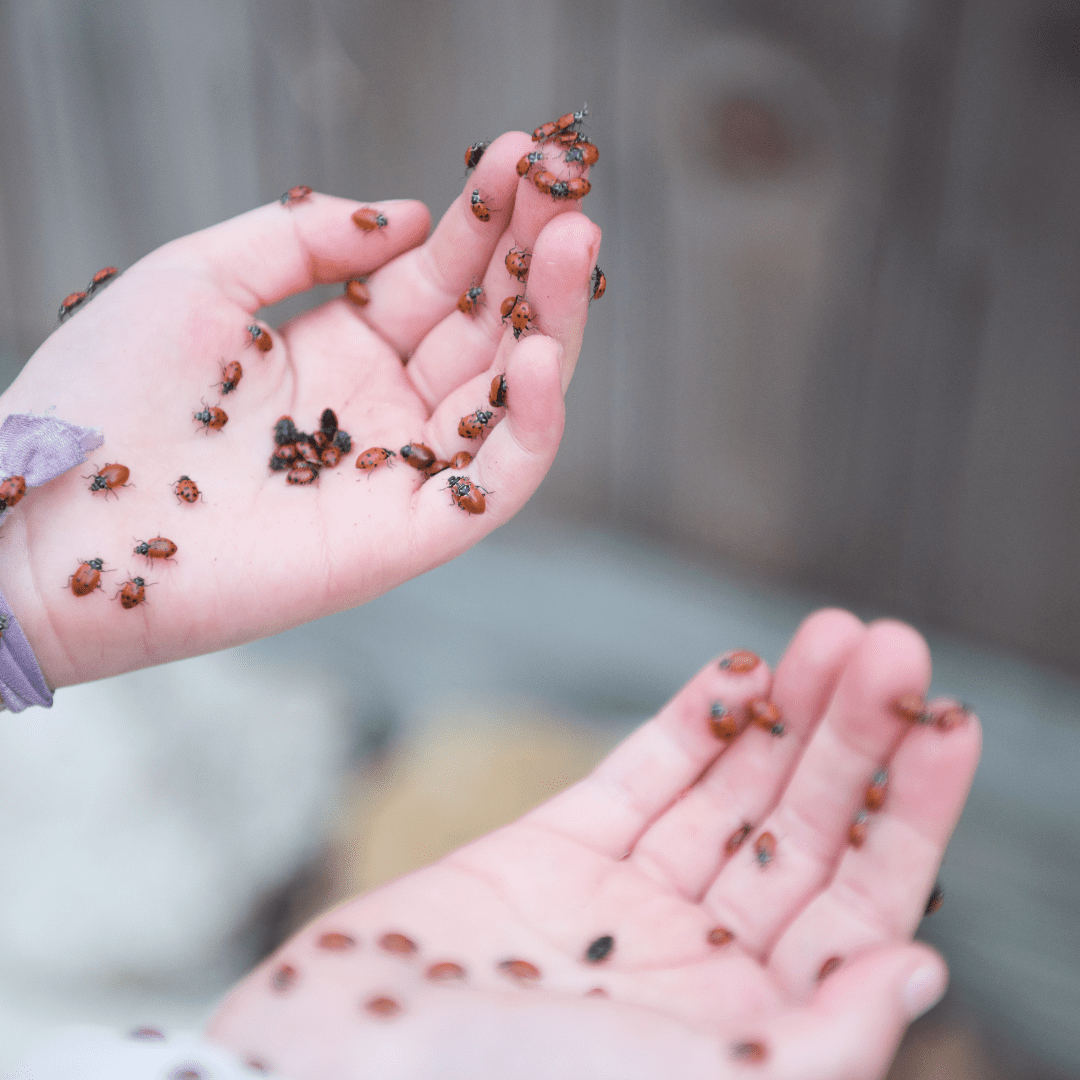Wondering how to release ladybugs in your garden for organic pest control? These beneficial insects are a natural solution for managing aphids, mites, and other pests—no chemicals needed. Learn the best time, method, and conditions to release ladybugs so they stay, thrive, and help protect your garden the natural way.
If you’re looking for a natural, eco-friendly way to protect your garden from destructive pests, ladybugs are your secret weapon. These tiny, spotted beetles aren’t just cute—they’re fierce predators of aphids, spider mites, and other harmful insects that threaten your plants.
In this post, I’ll show you exactly how to release ladybugs in your garden for organic pest control, so you can keep your garden healthy without relying on chemicals. Whether you’re growing vegetables, herbs, or flowers, ladybugs are one of nature’s best allies—and they’re surprisingly easy to work with.
This is a pinnable post. Tap or hover over any image in this post to pin to your Pinterest Boards.
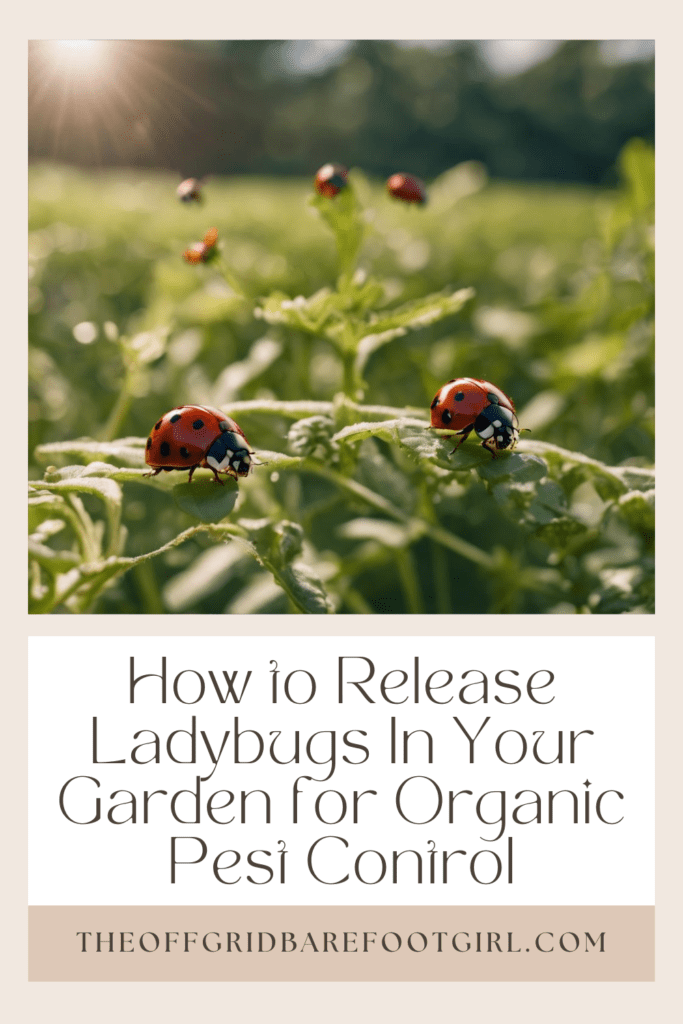
Introduction to Ladybugs as Organic Pest Control
What are Ladybugs?
Ladybugs, also known as ladybirds or lady beetles, are small, colorful insects that are often recognized by their distinctive round shape and spotted patterns. These adorable little bugs are not just eye candy for your garden; they also play a crucial role in natural pest control.
Ladybugs as Natural Predators
Ladybugs are voracious eaters, especially when it comes to garden pests. They have a hearty appetite for aphids, mites, scale insects, and other soft-bodied insects that can wreak havoc on your precious plants. Each ladybug can consume dozens of pests per day, making them quite the efficient garden warriors.
Benefits of Using Ladybugs for Pest Control
Using ladybugs for pest control in your garden offers several benefits.
- Firstly, it is an organic and chemical-free way to manage pests, ensuring that your garden remains healthy and safe for you, your family, and the environment.
- Secondly, ladybugs are selective eaters, targeting harmful insects while leaving beneficial insects unharmed.
- Lastly, ladybugs can be a cost-effective solution as they can significantly reduce the need for pesticides and insecticides.
Understanding the Benefits of Ladybugs in Garden Pest Management
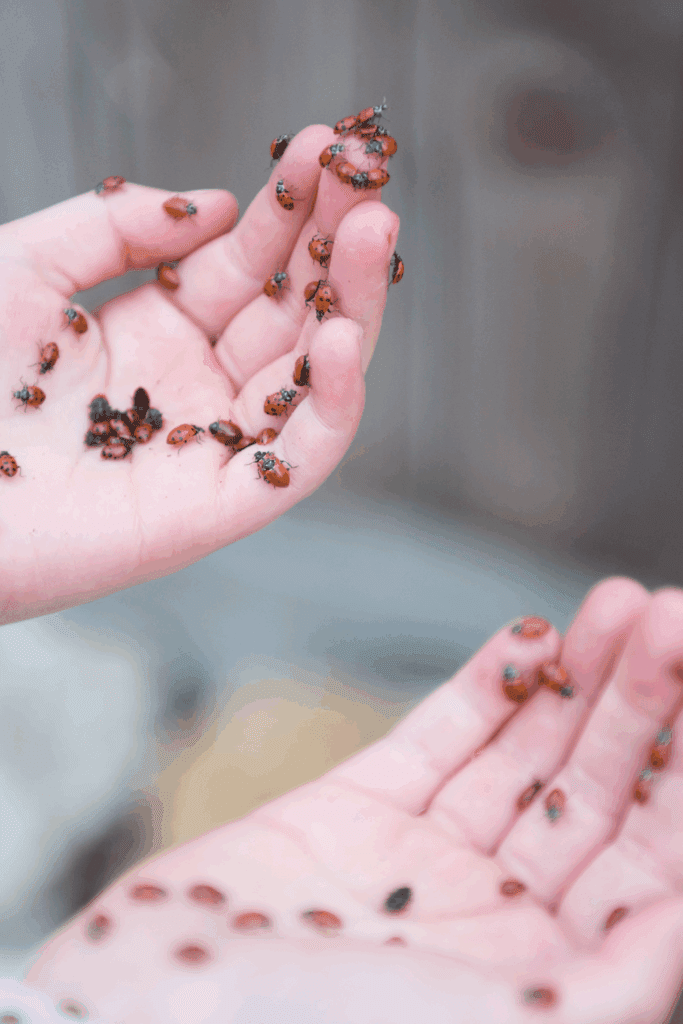
Ladybugs and Integrated Pest Management
Ladybugs are an essential component of integrated pest management strategies. Integrated pest management focuses on using a combination of techniques to manage pests while minimizing the use of chemicals. Ladybugs act as natural biocontrol agents, reducing the reliance on synthetic pesticides and promoting a more sustainable approach to pest management.
Ladybugs as an Environmentally Friendly Pest Control Option
Unlike chemical pesticides that can have harmful effects on the environment and beneficial insects, ladybugs provide an environmentally friendly pest control option. They are a natural solution that maintains the delicate balance of your garden ecosystem while effectively controlling pests.
Ladybugs as Effective and Targeted Natural Predators
Ladybugs are not only effective in pest control, but they are also highly targeted predators. They can seek out and find pests hiding on plants, including hard-to-reach areas such as the undersides of leaves. Their excellent hunting skills make them an efficient and reliable ally in the fight against garden pests.
Selecting and Purchasing Ladybugs for Release
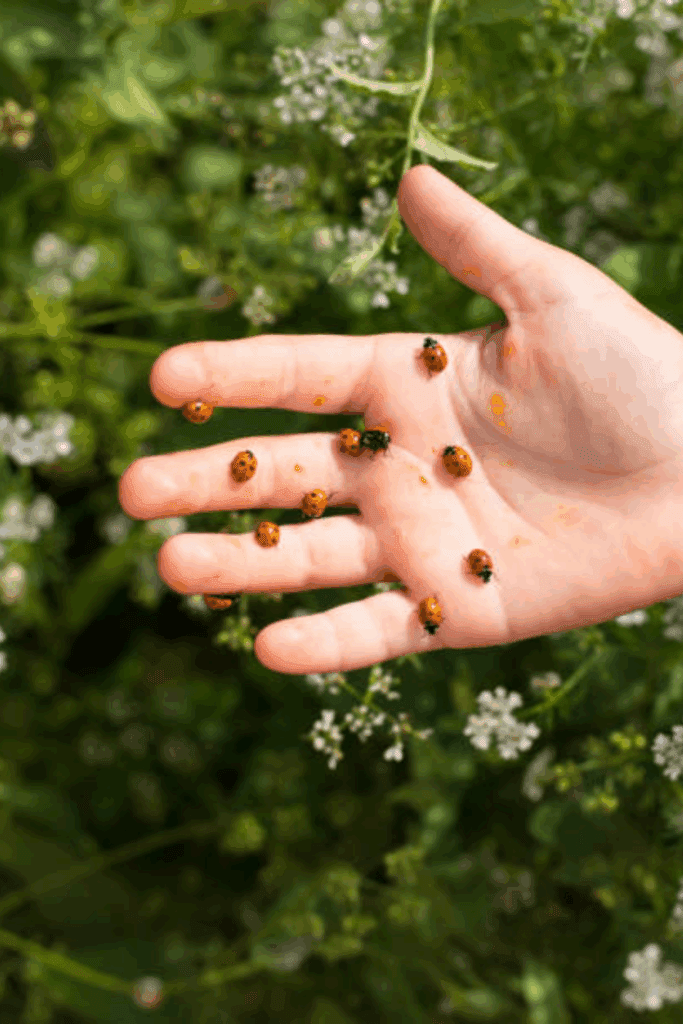
Researching Ladybug Species and Varieties
Before making a purchase, it is important to research and understand the different ladybug species and varieties available. Certain species are more effective at controlling specific pests, so identifying which ladybugs will best suit your needs is essential.
Finding Reputable Suppliers
To ensure the quality and health of the ladybugs you purchase, it is crucial to find a reputable supplier. Look for suppliers that specialize in organic pest control solutions and have positive customer reviews. This will increase the chances of receiving healthy and active ladybugs for release. I love shopping for my ladybugs from Nature’s Good Guys on Amazon! They have excellent reviews!
Assessing Ladybug Quality and Quantity
When purchasing ladybugs, consider quality and quantity. Look for suppliers that provide live ladybugs, preferably adults, as they are more likely to stay in your garden. Additionally, ensure that you are getting an adequate number of ladybugs to effectively control pests in your specific garden size.
For my backyard homestead with a vegetable patch and a micro orchard, I release 1,500 ladybugs in the spring for effective organic pest control. I keep my gardens well-watered and created a bug hotel in the corners of my homestead to help keep the ladybugs comfortable and populated so they do not fly away elsewhere.
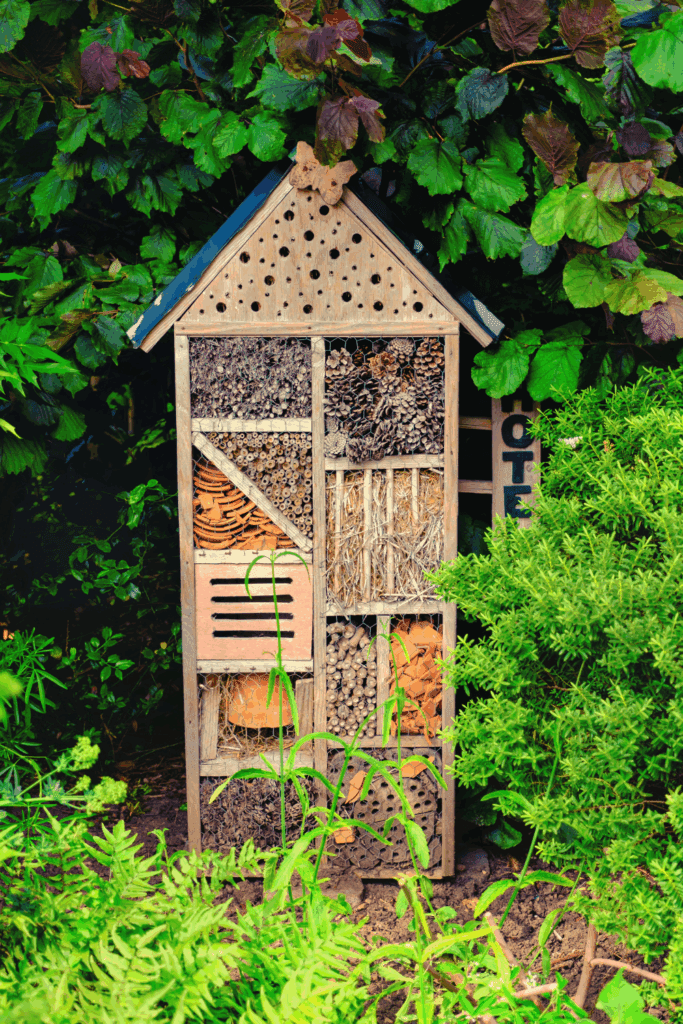
Preparing Your Garden for Ladybug Release
Identifying Pest Problems in Your Garden
Before releasing ladybugs, it is crucial to identify the specific pest problems in your garden. This will help you determine the number of ladybugs you require and target their deployment to areas that need the most attention.
Creating an Attractive Environment for Ladybugs
To encourage ladybugs to stay and thrive in your garden, create an inviting environment. Planting a variety of flowers, particularly those that produce nectar, will attract ladybugs and provide them with a food source. Additionally, providing shelter such as dense plants or small piles of leaves can give ladybugs a cozy home.
Addressing Any Potential Harmful Factors
Before releasing ladybugs, address any potential factors that could harm them. If you have recently used chemical pesticides, wait for the recommended period before introducing ladybugs.
Also, be cautious of ant infestations, as ants can harm ladybug larvae. Addressing these factors will ensure that your ladybugs have the best chance of success in controlling pests in your garden.
Releasing Ladybugs: Best Practices and Techniques

Timing the Ladybug Release
When it comes to releasing ladybugs in your garden, timing is everything. For optimal effectiveness, release your ladybugs in the evening when the temperatures are cooler and after you have watered your garden.
This way, they can settle in comfortably without getting stressed out by the midday heat and will drink the water before settling for the night rather than flying away to your neighbor’s garden.
Properly Handling and Distributing Ladybugs
Ladybugs may be tiny, but they deserve the utmost care when you release them. Treat them like the VIPs they are. Gently open the container and let them crawl onto the plants, rather than tossing them like confetti at a parade. You can also lightly mist the plants with water to create a welcoming environment for your new garden guests.
Strategic Placement of Ladybugs in the Garden
Think of yourself as a master strategist, placing your ladybugs like chess pieces on the board of your garden. Be strategic in distributing them across your plants, focusing on areas where pests tend to congregate.
Pay extra attention to plants plagued by aphids, mealybugs, or other soft-bodied insects – these are a ladybug’s favorite buffet! Encourage them to stay by providing nearby shelter and water sources.
Monitoring and Maintaining Ladybug Population in Your Garden
Assessing Ladybug Activity and Population Size
As a responsible ladybug host, it’s important to keep an eye on your tiny helpers. Regularly observe your garden to assess ladybug activity and population size. Are they actively patrolling your plants for pests? Are their numbers dwindling or flourishing? Adjust your organic pest control strategies accordingly.
Providing Adequate Food and Shelter for Ladybugs
Remember, ladybugs have needs, too! To maintain a healthy population, offer a diverse array of flowering plants that provide nectar and pollen. This will ensure a constant food supply for adult ladybugs and nourish their offspring.
Additionally, include plants with dense foliage or mulch to create sheltered areas where ladybugs can rest and lay their eggs.
Here’s a list of foods and plants that ladybugs love to feast upon:
- Aphids: Ladybugs are particularly fond of aphids, which are small, soft-bodied insects that can be pests on many plants.
- Scale Insects: Ladybugs feed on scale insects, which are often found on the stems and leaves of plants.
- Mealybugs: Ladybugs are effective predators of mealybugs, another group of plant-sucking pests.
- Spider Mites: Ladybugs consume spider mites, which can be problematic on a variety of plants.
- Whiteflies: Whiteflies are small, flying insects that can be found on the undersides of leaves, and ladybugs help control their populations.
- Thrips: Ladybugs feed on thrips, tiny insects that can damage plant tissues.
- Pollen and Nectar: Adult ladybugs also feed on pollen and nectar from various flowering plants.
To attract and support ladybugs in your garden, consider planting the following plants:
- Dill: Dill attracts ladybugs and provides them with a food source.
- Fennel: Fennel is another herb that attracts ladybugs and provides them with nectar.
- Coriander (Cilantro): Coriander is known to attract ladybugs when it bolts and produces flowers.
- Yarrow: Yarrow is a flowering plant that attracts beneficial insects, including ladybugs.
- Calendula: Calendula, with its bright and cheerful flowers, can attract ladybugs to your garden.
- Dandelion: While some consider dandelions as weeds, they can attract ladybugs when in bloom.
- Angelica: This herbaceous plant can attract ladybugs with its flower clusters.
By incorporating a variety of these plants and providing a diverse habitat, you can encourage ladybugs to stay in your garden and help control pest populations naturally.
Encouraging Ladybug Reproduction and Overwintering
Ladybugs are not just passing visitors – they can become permanent residents in your garden. Provide them with a comfortable environment for reproduction and overwintering.
Incorporate plants that produce ample pollen and nectar, as well as a mix of early-blooming and late-blooming varieties to support their life cycle. Make your garden a ladybug-friendly haven! Here are several ways to make your garden a haven for ladybugs:
- Plant a Variety of Flowers:
- Choose a diverse range of flowers to attract adult ladybugs. Plants such as dill, fennel, yarrow, calendula, and angelica are known to be appealing to ladybugs.
- Include Herbs:
- Herbs like dill, fennel, cilantro (coriander), and parsley can attract ladybugs both with their flowers and as a source of prey.
- Provide a Water Source:
- Ladybugs, like other insects, need water. Place shallow dishes with water in your garden, or create small water features to attract and provide a water source for them.
- Avoid Pesticides:
- Minimize or eliminate the use of chemical pesticides, as these can harm ladybugs and other beneficial insects. Ladybugs are natural predators and can help control pest populations without the need for harsh chemicals.
- Leave Some Weeds:
- Some weeds, like dandelions, can attract ladybugs. Consider leaving a small area of your garden with beneficial weeds that can provide both food and shelter.
- Plant Native Plants:
- Native plants are well-adapted to your local ecosystem and can attract a variety of beneficial insects, including ladybugs.
- Create Shelter:
- Ladybugs need shelter during the day. Provide hiding places by incorporating ground cover, dense vegetation, or even small piles of rocks or logs.
- Use Ladybug Houses:
- You can purchase or make ladybug houses, which are small structures that provide shelter and encourage ladybugs to stay in your garden.
- Limit Artificial Lighting:
- Excessive artificial lighting can disrupt the natural behaviors of insects, including ladybugs. Minimize outdoor lighting, especially during the night.
- Avoid Overuse of Nitrogen Fertilizers:
- While plants need nutrients, excessive use of nitrogen fertilizers can encourage aphid populations. Aphids are a primary food source for ladybugs, so a balanced approach to fertilizing can be beneficial.
Integrating Ladybugs with Other Organic Pest Control Methods

Using Ladybugs in Conjunction with Beneficial Insects
Ladybugs are team players, and they work well with others – especially other beneficial insects. Combine the forces of ladybugs, lacewings, and beetles to create an unstoppable army against garden pests.
Each insect brings its own unique set of skills to the table, ensuring your garden remains pest-free without the need for harsh chemicals. Here are some beneficial insects that work well with ladybugs in managing pest populations:
- Predatory Beetles:
- Ground beetles and rove beetles are effective predators of various garden pests, including caterpillars, slugs, and insect eggs.
- Parasitic Wasps:
- Tiny parasitic wasps, such as braconid and Trichogramma wasps, lay their eggs on or inside the bodies of pest insects. These wasps are especially useful for controlling caterpillar and aphid populations.
- Lacewings:
- Both adult lacewings and their larvae are voracious predators of aphids, mites, and other small insects. They are particularly beneficial in controlling aphid infestations.
- Hoverflies (Syrphid Flies):
- Adult hoverflies feed on nectar, but their larvae are effective predators of aphids. Attracting hoverflies can help control aphid populations in your garden.
- Minute Pirate Bugs:
- These tiny predators feed on various small pests, including spider mites, thrips, and aphids. Minute pirate bugs are generalist predators and can be beneficial in diverse garden ecosystems.
- Praying Mantises:
- Praying mantises are generalist predators that feed on a variety of insects, including moths, flies, and beetles. They can contribute to controlling a wide range of pests.
- Ground-Nesting Bees:
- Many native bees, such as solitary ground-nesting bees, are important pollinators. Supporting a healthy bee population benefits your garden by enhancing pollination and overall ecosystem health.
- Predatory Mites:
- Predatory mites are effective in controlling harmful mites. They feed on spider mites and other plant-damaging mites, helping to maintain a balanced ecosystem.
- Dragonflies and Damselflies:
- Both dragonflies and damselflies are voracious predators of flying insects, including mosquitoes, flies, and gnats. They are beneficial in controlling pest populations around water features.
Incorporating Ladybugs into Companion Planting
Companion planting is like throwing a garden party, and ladybugs are the life of the party. Strategically interplant flowers, herbs, and vegetables that attract ladybugs, such as dill, fennel, yarrow, and marigolds. These plants not only provide a beautiful spectacle, but also lure ladybugs to the feast of pests in your garden.
Enhancing Ladybug Effectiveness with Organic Pest Control Products
Sometimes, even superheroes like ladybugs need a little extra help. Supplement their efforts with organic pest control products, such as neem oil or insecticidal soaps, to tackle persistent pest problems. Just remember to use these products sparingly and in harmony with the ladybugs’ sustainable pest control methods.
Ladybugs: The Secret Superheroes of Your Garden

The Amazing Benefits of Ladybug Populations in Gardens
Don’t underestimate the power of these tiny red and black-spotted insects. Ladybugs are the unsung heroes of your garden, tirelessly combating pests that threaten the health of your plants.
By keeping pest populations under control, they help maintain the delicate ecosystem of your backyard oasis. Here are several benefits of having a healthy ladybug population in your garden:
- Natural Pest Control:
- Ladybugs are predators of many common garden pests, such as aphids, scale insects, mealybugs, spider mites, and thrips. They are particularly effective at controlling aphid populations.
- Reduction of Aphid Infestations:
- Aphids are a common nuisance in gardens, feeding on plant sap and potentially spreading diseases. Ladybugs help keep aphid populations in check, preventing damage to plants.
- Prevention of Plant Damage:
- By feeding on pest insects, ladybugs help prevent damage to plant tissues caused by sap-sucking pests. This can result in healthier and more robust plants.
- Minimized Need for Chemical Pesticides:
- The presence of ladybugs can reduce the need for chemical pesticides in the garden. This supports environmentally friendly gardening practices and helps maintain a balanced ecosystem.
- Control of Mites and Thrips:
- Ladybugs also prey on harmful mites and thrips, which can damage plant tissues and reduce the overall health of plants.
- Beneficial for Fruit and Vegetable Crops:
- Ladybugs are especially helpful in orchards and vegetable gardens, where they contribute to the natural control of pests that can affect crop yields.
- Year-Round Pest Control:
- Ladybugs can be active throughout the growing season, providing continuous pest control in gardens. This is especially beneficial in regions with diverse insect populations.
- Encouragement of a Balanced Ecosystem:
- Ladybugs contribute to the overall biodiversity of your garden by acting as a key player in the natural predator-prey relationships. This helps maintain a balanced and healthy ecosystem.
- Attraction to Nectar and Pollen:
- Adult ladybugs feed on nectar and pollen, making them important pollinators. By attracting ladybugs to your garden, you support pollination, which is essential for the reproduction of many flowering plants.
Ladybugs: Nature’s Adorable Pest Control Technicians

Move over, exterminators! Ladybugs are the cutest pest control technicians around. With their vibrant colors and charming appearance, they bring a touch of whimsy to your garden while silently going about their work of devouring aphids, mealybugs, and other garden nuisances. Who needs a pest control truck when you can have a squadron of ladybugs?
Ladybugs: Not Just for Kids’ Science Projects Anymore!
Remember collecting ladybugs as a kid and watching them crawl around in a jar? Well, those little critters were onto something. Ladybugs are not just playthings; they are powerful allies in maintaining a healthy, pest-free garden.
So, invite these miniature heroes into your backyard and let them work their magic. Your plants will thank you, and you’ll have a front-row seat to the captivating world of ladybug pest control!
Conclusion
By incorporating ladybugs into your garden as organic pest control, you are not only promoting the health and balance of your garden ecosystem but also reducing the need for harmful chemical pesticides. Ladybugs offer a natural and effective solution to combat common garden pests, while also adding a touch of beauty to your outdoor space.
Remember to monitor their population, provide suitable habitats, and integrate them with other organic pest control methods for optimal results. Embrace the power of ladybugs and enjoy a flourishing, pest-free garden that is both environmentally friendly and visually stunning.
Resources: Here are some helpful resources for further information.
- How to Release Ladybugs in the Garden – By Stacyling
- Releasing Ladybugs into the Garden – By Fine Gardening
- Release the Ladybugs – By Garden Web
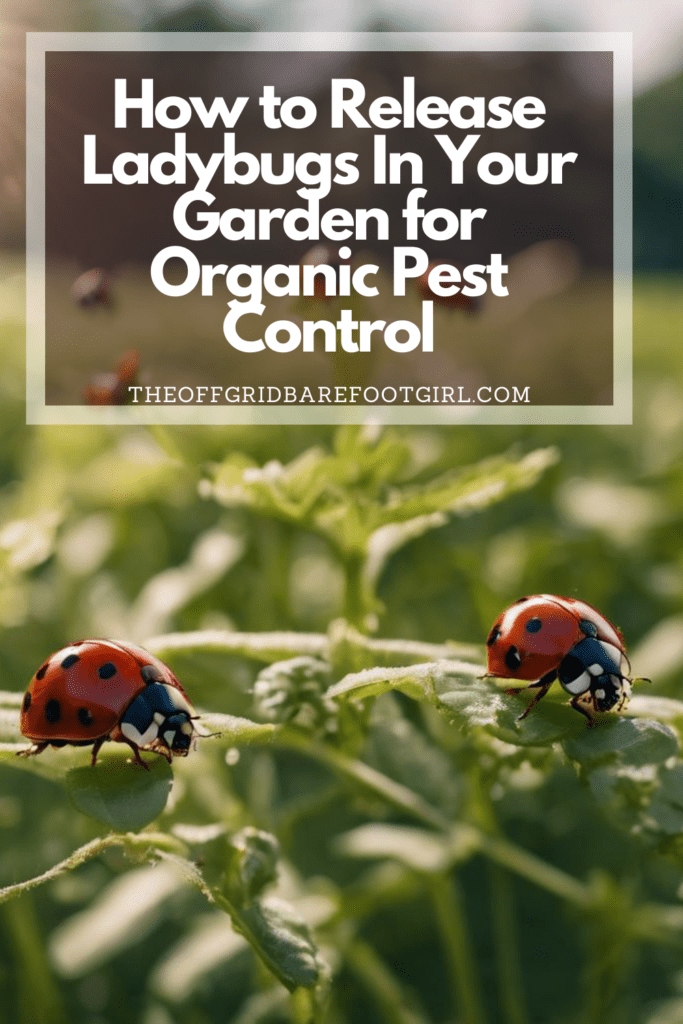
Frequently Asked Questions
1. Are ladybugs harmful to plants or humans?
No, ladybugs are not harmful to plants or humans. They are beneficial insects that primarily feed on garden pests such as aphids, mites, and scales. Ladybugs do not pose any threat to the health of your plants or endanger human well-being.
2. How many ladybugs should I release in my garden?
The number of ladybugs to release in your garden depends on the size of your garden and the severity of the pest problem. As a general guideline, you can release around 1,000 ladybugs per 1,500 square feet. However, it’s important to note that releasing more ladybugs does not necessarily mean better pest control. It is advisable to start with a moderate number and monitor the results before deciding if additional releases are necessary.
3. Can I buy ladybugs from any supplier?
No, it is essential to purchase ladybugs from reputable suppliers. Ensure that the supplier specializes in biological pest control and provides healthy, viable ladybugs. Research the supplier’s reputation, read reviews, and inquire about their packaging and shipping methods to ensure the quality and survival of the ladybugs during transit.
4. How long does it take for ladybugs to establish in my garden?
The establishment time for ladybugs in your garden can vary. Some ladybugs may start feeding on pests immediately after release, while others may take a few days to acclimate and locate the pests. It’s important to create a conducive environment by providing food sources, shelter, and water for ladybugs to encourage their establishment and reproduction. With proper conditions, you can expect to see a noticeable reduction in pest populations within a few weeks.
Summary
I hope I have inspired you to release ladybugs in your garden with these tips and products.
If you were encouraged by this post, I invite you to check out my FREE Printables Page for fun free printables, planners, and charts.
ENTER MY FREE Printables Page HERE
Here are some more of my gardening inspiration posts to check out!
The Best Garden Snail Control Strategies
The Best Spring Vegetables to Grow in Your Garden
Seed Starter Mix: How To Make Your Organic Seed Starter Mix At Home
How to Grow a Productive Canning Garden
How to Plant and Grow a Salsa Garden
Easiest Heirloom Vegetable Seeds to Grow Now
How to Use the Hand Twist Claw Tiller: Tackling Tough Soil
Planning Your Garden: How to Plan a Vegetable Garden: Expert Green Thumb Tips!
Winterizing the Garden: How to Winterize Your Vegetable Garden: Step-by-Step Checklist
Mulching the Garden: How to Make Leaf Litter Mulch
Grow a Pumpkin Patch: How to Grow a Pumpkin Patch in Your Backyard
How to Win a Giant Pumpkin Contest
How to Grow a Fall Garden: 9 Best Fall Crops
Clever Ways to Incorporate Indoor Composting into Your Home
How to Start Composting for the Garden: A Step-by-Step Guide
The Ultimate Guide to Composting in Your Suburban Backyard
Why I Built A Survival Garden in My Backyard
How to Grow A Foodscape Garden From Scratch
16 Best Medicinal Herbs to Grow in Your Garden Now
Blessings,
The Off Grid Barefoot Girl

